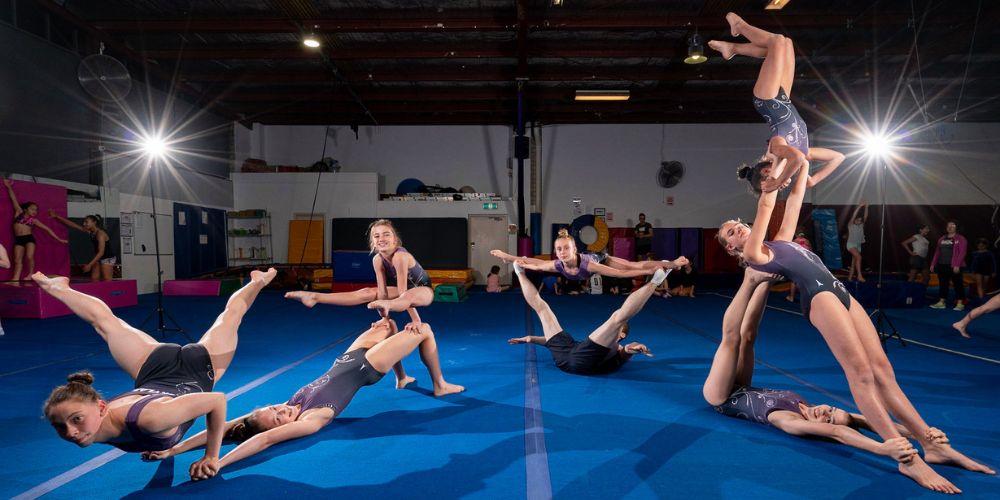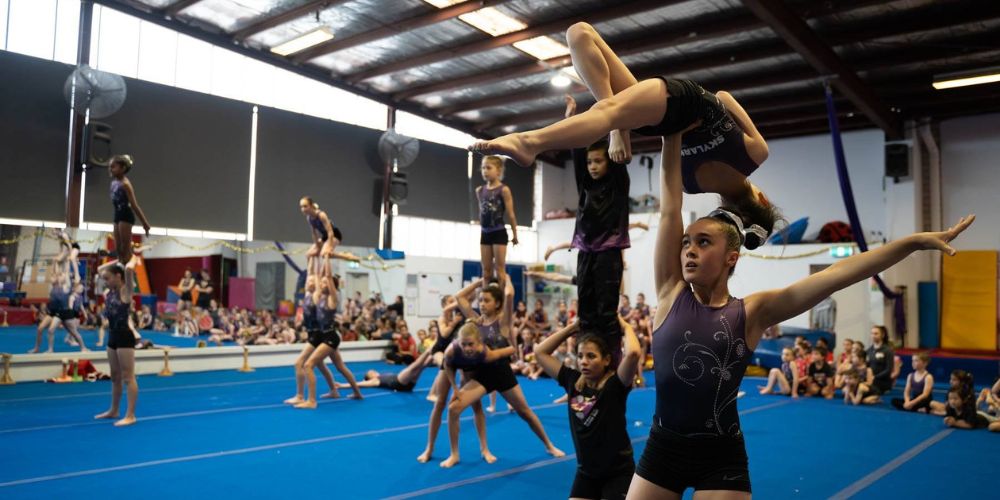The Art and Power of Gymnastics: More Than Just Flips and Flexibility

When most people think of gymnastics, they picture gravity-defying flips, elegant floor routines, and the intense focus of Olympic athletes. But gymnastics is so much more than a display of physical feats — it is a lifelong discipline that combines strength, coordination, flexibility, grace, and mental resilience.
Whether you’re a parent considering gymnastics for your child, a teen dreaming of competition, or an adult looking for a unique fitness outlet, this guide will walk you through the world of gymnastics and why it’s one of the most complete sports out there.

What is Gymnastics?
Gymnastics is a sport that involves performing sequences of movements requiring physical strength, flexibility, balance, agility, and coordination. It has ancient roots — dating back to ancient Greece — and has evolved into various modern disciplines.
The most well-known categories include:
-
Artistic Gymnastics: The most popular form, seen in the Olympics. Men compete in six events (e.g., rings, pommel horse), and women in four (e.g., balance beam, floor).
-
Rhythmic Gymnastics: A blend of dance and gymnastics performed with apparatus like ribbons, hoops, and balls.
-
Trampoline: Athletes perform high-flying acrobatic routines on a trampoline.
-
Acrobatic and Aerobic Gymnastics: Focus on group routines, emphasizing timing, strength, and choreography.
The Benefits of Practicing Gymnastics
Gymnastics isn’t just for professional athletes. It offers a host of benefits for people of all ages and skill levels:
1. Full-Body Strength
Every movement in gymnastics engages multiple muscle groups. Core strength is key, but you’ll also develop power in your arms, legs, and back — all without needing heavy weights.
2. Flexibility and Mobility
Stretching is built into every practice. Improved flexibility can prevent injuries and improve posture, even in daily life.
3. Balance and Coordination
Balancing on a beam or swinging on bars trains the nervous system to control the body with precision — skills that translate into many other sports and daily tasks.
4. Discipline and Focus
Gymnastics demands concentration, patience, and consistent effort. These qualities build mental strength and can benefit academic and professional performance.
5. Confidence and Body Awareness
Mastering a new skill — like your first handstand or backflip — is empowering. Gymnastics helps individuals become more aware and in control of their bodies.
Gymnastics for Kids: Why Start Young?
Children who start gymnastics at a young age develop motor skills that serve them for life. It’s not about becoming the next Simone Biles or Kohei Uchimura — it’s about building a strong foundation.
Some benefits for children include:
-
Enhanced brain development through movement learning
-
Early social skills via group classes
-
Improved discipline and self-esteem
-
A healthy alternative to screen time
That said, it’s never too late to start. Many gyms offer adult gymnastics or beginner-friendly acrobatics and tumbling classes for all ages.
Gymnastics Training: What to Expect
A typical gymnastics training session depends on the discipline and skill level, but here’s a general breakdown:
Warm-up and Stretching
Crucial for injury prevention and preparing the body for movement. It usually includes dynamic stretches, light cardio, and joint mobility drills.
Skill Training
Athletes focus on specific movements — from basic rolls and handstands to advanced tumbling and apparatus work. Coaches break down skills into progressions to build them safely.
Strength and Conditioning
Exercises like planks, leg lifts, pull-ups, and core work are common. Gymnastics relies on bodyweight strength, making this part of training vital.
Cool Down
Usually involves static stretching, breathing exercises, and sometimes light massage or foam rolling.
Common Challenges and How to Overcome Them
Every sport has its hurdles. Here are some challenges new gymnasts face and tips to tackle them:
-
Fear of Falling or Injury: Start slow. Spotting by coaches, foam pits, and safety mats help reduce risk and build confidence.
-
Frustration with Progress: Skills take time to learn. Trust the process and celebrate small wins along the way.
-
Physical Demands: Soreness is normal at first. Rest, hydration, and proper nutrition help recovery.
-
Mental Blocks: Visualization, breathing techniques, and positive self-talk can help overcome mental barriers.
Nutrition for Gymnasts
Fueling your body is just as important as training. Here’s how gymnasts — especially competitive ones — should think about nutrition:
-
Carbohydrates provide energy for intense training.
-
Proteins help repair and build muscle.
-
Healthy fats support brain function and hormone health.
-
Hydration is critical, especially during long sessions.
-
Micronutrients (calcium, iron, vitamin D) are essential for bone strength and muscle function.
Avoid restrictive diets — gymnasts need balanced meals to support both performance and recovery.
Gymnastics as a Career or Hobby
For some, gymnastics is a path to national teams, scholarships, or even the Olympics. For others, it’s a joyful hobby that keeps them active and engaged.
You don’t have to compete to enjoy gymnastics. Many people practice recreationally or as a cross-training tool for other sports like dance, martial arts, or parkour.
In recent years, adult gymnastics classes have gained popularity. Whether you want to master a backflip, improve mobility, or challenge yourself in new ways, there’s a place for you.

Safety First: Choosing the Right Gym
Safety and proper coaching are essential in gymnastics. When selecting a gym, consider:
-
Certified and experienced coaches
-
Clean and well-maintained equipment
-
Safety gear like mats, harnesses, and spotting techniques
-
Positive and inclusive environment
-
Classes appropriate for your age and level
Final Thoughts: Embrace the Gymnast Within
Gymnastics is more than just a sport — it’s a journey of self-discovery, discipline, and joy. Whether you’re aiming for the podium or simply want to improve your health and agility, gymnastics offers something for everyone.
It teaches us to fall and get back up, to aim for precision, and to appreciate the limits and potential of our own bodies. In a world that’s constantly moving, gymnastics asks us to slow down and master movement with intent.
So, the next time you see a gymnast fly through the air or hold a perfect handstand, remember: that grace and power started with one small step — and you can take it too.
